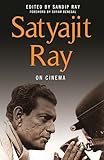Satyajit Ray on Cinema / Satyajit Ray; ed. by Sandip Ray.
Material type: TextPublisher: New York, NY : Columbia University Press, [2013]Copyright date: ©2013Description: 1 online resource (184 p.) : 24-page insertContent type:
TextPublisher: New York, NY : Columbia University Press, [2013]Copyright date: ©2013Description: 1 online resource (184 p.) : 24-page insertContent type: - 9780231164955
- 9780231535472
- 791.4302/33092 B 23
- PN1998.3.R4 A3 2011
- PN1998.3.R4 A3 2013
- online - DeGruyter
- Issued also in print.
| Item type | Current library | Call number | URL | Status | Notes | Barcode | |
|---|---|---|---|---|---|---|---|
 eBook
eBook
|
Biblioteca "Angelicum" Pont. Univ. S.Tommaso d'Aquino Nuvola online | online - DeGruyter (Browse shelf(Opens below)) | Online access | Not for loan (Accesso limitato) | Accesso per gli utenti autorizzati / Access for authorized users | (dgr)9780231535472 |
Frontmatter -- Contents -- Preface -- Foreword -- Part One. The Film-Maker'S Craft -- 1. National Styles in Cinema -- 2. Notes on Filming Bibhuti Bhusan -- 3. Should a Film-Maker Be Original? -- 4. This Word 'Technique' -- 5. All These Devices -- 6. The Changing Face of Films -- 7. The Question of Reality -- 8. The Confronting Question -- 9. A Film Must Achieve its Objective -- 10. Thoughts on the Camera -- 11. 'I Wish I Could Have Shown Them To You' -- 12. The New Cinema and I -- 13. Under Western Eyes -- 14. The Art of Silence -- Part Two. Pen Portraits -- 15. A Word About Godard -- 16. The New Antonioni -- 17. The Nayak -- 18. 'Never Use Animals' -- 19. The Immortal Tramp -- Part Three. Celebrating Cinema -- 20. Arrival in Moscow -- 21. Film Festivals -- 22. Our Festivals, Their Festivals -- Filmography -- Satyajit Ray'S Contributions to Films Other than His Own -- Awards Won by Satyajit Ray -- Index -- Preserving a Legacy
restricted access online access with authorization star
http://purl.org/coar/access_right/c_16ec
Satyajit Ray, one of the greatest auteurs of twentieth century cinema, was a Bengali motion-picture director, writer, and illustrator who set a new standard for Indian cinema with his Apu Trilogy: Pather Panchali (Song of the Little Road) (1955), Aparajito (The Unvanquished) (1956), and Apur Sansar (The World of Apu) (1959). His work was admired for its humanism, versatility, attention to detail, and skilled use of music. He was also widely praised for his critical and intellectual writings, which mirror his filmmaking in their precision and wide-ranging grasp of history, culture, and aesthetics. Spanning forty years of Ray's career, these essays, for the first time collected in one volume, present the filmmaker's reflections on the art and craft of the cinematic medium and include his thoughts on sentimentalism, mass culture, silent films, the influence of the French New Wave, and the experience of being a successful director. Ray speaks on the difficulty of adapting literary works to screen, the nature of the modern film festival, and the phenomenal contributions of Jean-Luc Godard and the Indian actor, director, producer, and singer Uttam Kumar. The collection also features an excerpt from Ray's diaries and reproduces his sketches of famous film personalities, such as Sergei Eisenstein, Charlie Chaplin, and Akira Kurosawa, in addition to film posters, photographs by and of the artist, film stills, and a filmography. Altogether, the volume relays the full extent of Ray's engagement with film and offers extensive access to the thought of one of the twentieth-century's leading Indian intellectuals.
Issued also in print.
Mode of access: Internet via World Wide Web.
In English.
Description based on online resource; title from PDF title page (publisher's Web site, viewed 02. Mrz 2022)


